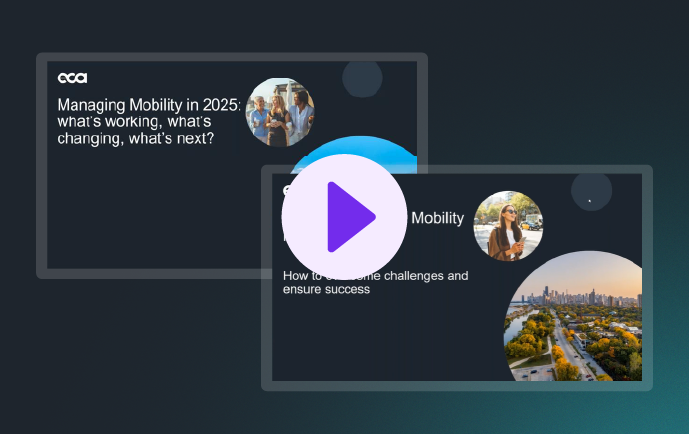The global mobility landscape is undergoing rapid transformation as organisations respond to shifting business priorities, evolving technologies, and changing workforce expectations. In today’s environment, mobility leaders must navigate complexity while driving strategic value for their organisations.
In our recent webinar series, we shared the latest insights from our 2025 Managing Mobility Survey, which captured perspectives from over 260 organisations spanning more than 30 countries and industries. The findings reveal what’s working well, where GM teams are adapting, and what’s on the horizon.
If you missed the live sessions, you can catch up now - we’ve made the recordings and key takeaways available to help you stay informed and ahead of the curve.
Key takeaways:
- Mobility remains critical and flexibility is key
Most organisations report an increase in all types of mobility, from long-term assignments to permanent transfers, and the overwhelming majority of organisations utilise multiple mobility types to cater to the business environment and employee needs.
- Barriers to mobility have increased
While organisations anticipate more moves, our data shows that candidates are rejecting moves in greater numbers. Almost 50% of organisations report difficulties encouraging staff to accept long-term assignments, with reasons for rejection being both financial and non-financial. Organisations who offer more comprehensive planning and preparation to their employees, as well as more flexibility, are more likely to be successful than those who do not.
- Shift towards strategic mobility and closer integration with talent management
19% of GM teams now operate in a primarily strategic role (up from 10% in 2021), dealing better with the challenge of measuring ROI and providing stronger alignment with talent goals. Strategic GM teams are more involved across the assignment lifecycle, and greater involvement reduces assignment failures and supports talent retention.
- Cost control is critical
The cost of administering mobility has increased significantly in the past four years. As the mobility function is trying to move more people, it also needs to do so cost-effectively. Technology can be a great enabler of this, delivering efficiency gains, reducing errors and streamlining the process of moving people.
- Technology adoption is uneven
While technology can improve the mobility process, its adoption is limited. For example, while the majority of organisations perform cost estimates as part of assignment planning, most do so using Excel. Over half of GM teams lack integrated systems, with budget constraints as the main barrier, limiting their ability to improve oversight and productivity. Building business cases showing the potential savings in terms of costs and time savings can help gain support from leadership.
- Future focus areas
The future of GM will centre on deeper integration with business strategy, leveraging technology for data-driven decisions and adopting AI to enhance mobility programme effectiveness.
Webinar recordings
Click below to access the full recordings:

Ensure success with data-driven mobility strategies
Our Managing Mobility Survey report reveals how companies worldwide are adapting their strategies to meet today’s challenges, from cost control and talent retention to technology adoption and ROI.
Free for survey participants and available for purchase, the report offers powerful insights to help shape your mobility programme.
If you’re interested in the full report or our wider data solutions, get in touch with us today.